Two weeks after the auction in 1918, we read in the July 31st Register and Matawan
Journal edition at the the time, that the Magnolia Farm was sold to the colorful Clarence Ware.
The
property is discribed as "consisting of 98 acres, large main house, about a dozen outbuildings, two other dwellings,
stable, etc, and was valued at $50,000".
On the map below I've outlined what I believe the lot looked
like in 1918 based on a 1915 Matawan Township tax map, and a 1938 Marlboro tax map.
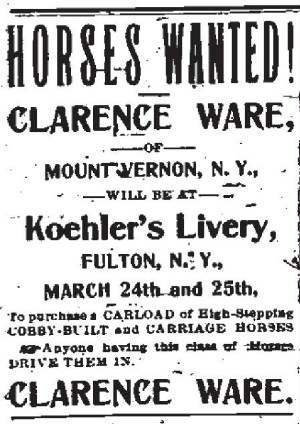
Clarence Ware was a well known horse dealer from Mount Vernon New York, and so
continued the Magnolia Farm's long tradition in horses.
As seen in the add to the right, from an
up-state newspaper, he would buy and sell horses by the car load.
He would also speculate on trotters, often buying
and selling the same day.
In
his younger days Clarence was a jockey, and not above (at least the appearance of) shenanigans. In the article below
from 1886, Clarence is accused of getting a new jockey drunk, and then selling his horse. The charges were later dismissed.
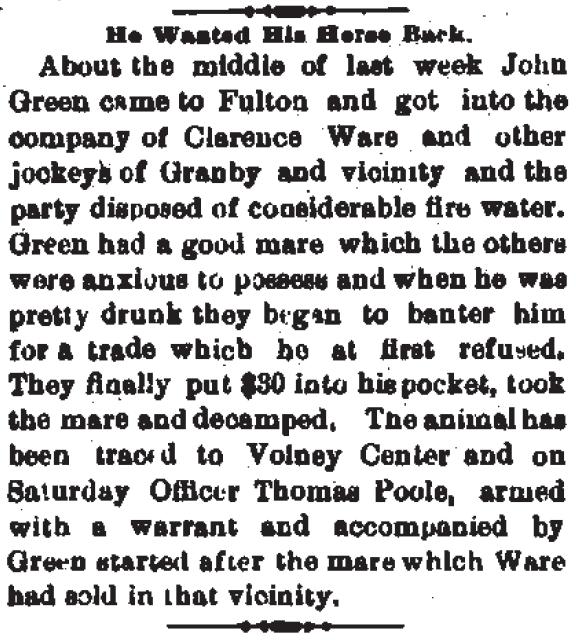
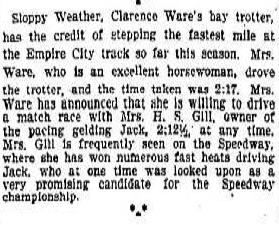
One of Clarence Ware's more successful
trades (at least from what we can glean a hundred years later) was the trotter "Sloppy Weather".
As seen
in the article to the right, like the Higgins before them, the Wares were both accomplished horse people, with Clarence's
wife Francis actually driving the horse to victory, and boldly challanging a comtemporary to a match race.
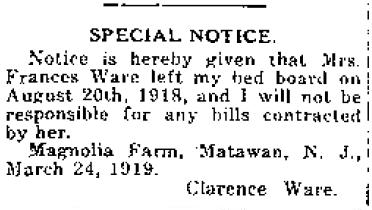
Sadly,
however, the Wares did not share Magnolia Farm as Clarence's wife never lived here.
We don't know whether
moving to Jersey was the cause or affect of the seperation, but though they would never divorce, Francis lived with her
sister in New York until she died in 1941. Below from Nov of 1919 we see that Clarence tried to sell it almost immediately
(but he would stay there for almost 30 years). 
However Clarence did begin selling off the Magnolia Farm and began getting
more interested in the Freneau connection. The excerpt from a Matawan Journal article from 1927 below describes
a couple of sales including the portion on the other side of Rt. 79.
This NY Times article from the same year mentions his engagment with
the Monmouth Historical Society to try and sell them Freneau's grave.
The Monmouth County Historical
Society couldn't afford his asking price, so below records the efforts of a local dealership to get Henry Ford to buy
the place.
In
the end he didn't sell at that time, so Freneau remained in Locust Grove.
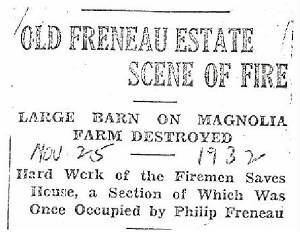
In 1932 there was a
major fire on the site when the large barn (125 ft) burnt down. The article at left says that a huge effort was required to
keep the house from burning down (again) also. It also says a large "garage" was saved. This may be the present
garage"as some estimates put it as old as the 20's.
Below is view of the house
from Freneau's monument across the street that shows the large detached garage. 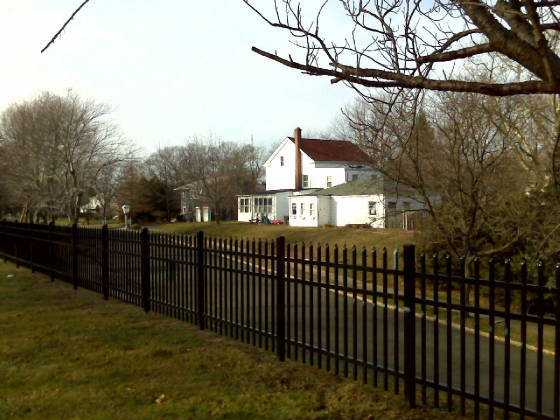
The "Printshop"
During the 30's he began even more vigorously promoting the Freneau connection
to his property. At
this time a "printshop" (small building attached to the main house in the location of my present kitchen) appeared. Clarence would conduct tours of the building (I
believe for 25 cents). There
were a few suspicious things about this claim: -
- First, the only reference to the existence of the print shop prior to this time was 50
years earlier in an article in the Monmouth Inquirer from July 31st, 1884, which stated that the "printing office stood
about 100 yards from the house, and excaped being burned".
- Second, Clarence stated he had no knowledge of the Freneau connection and never made
any mention of a printshop earlier, such as in 1927 when he was trying to sell the property.
- Lastly, in 1895 James B Ryer did a major renovation
employing the prominent architect H.A.Young, who would not have left the rather didilapidated shack attached to
the now stately house.
Never
the less, Clarence was quite busy in its promotion, especially in 1939. Below the WPA Writers Project "New Jersey- A Guide to its Present and Past"
includes the site on one of its tours.
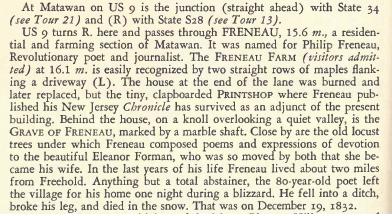
Below in another 1939 WPA book "Matawan
1636-1936" we see the property taking on its form that it would have for the next 35 years as the working "Magnolia
Farm" becomes "Poet's Dream" a 15 acre residential estate with a beautiful, maple lined, driveway.

Citizen Cane Another big event in 1939 was the attempted auction of the property. Clarence Ware prominantly featured
the Freneau connection in advertising for the sale.
The house was described as having fourteen
rooms- more than it has today. This would have included the large addition to the right of the "printshop",
removed in 1949 when the kitchen was built). It also highlights the hot-water heat.
Since the notice says that
it includes "fire logs" and "gas logs", this may mean that the original fireplace (which was likely on
the northside) was still used at that time.
The heating system is one of my favorite features of the house. The
system is industrial quality with enormous circulating pumps that keep the house as warm as we want without the dryness of
forced air. As
seen below, as was often the case (and I'm sure encouraged by Clarence) sale of the property always aroused interest.
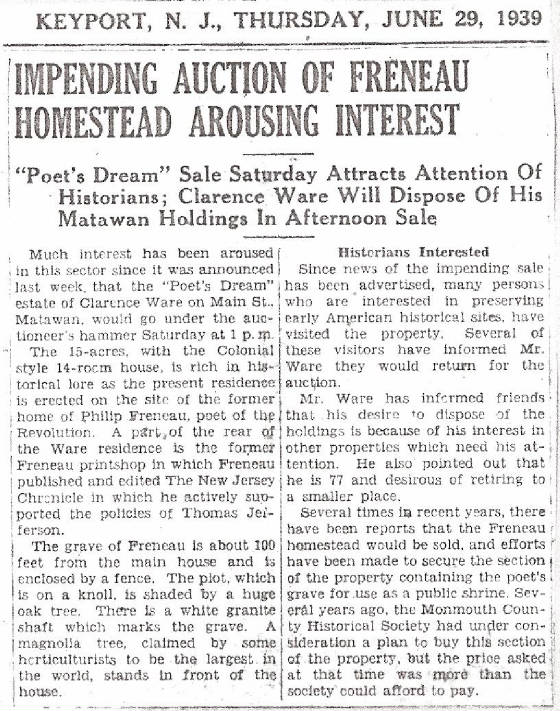
Below
we see that Clarence was not successful as the the only bid was $17,000, much less than he wanted. One interesting note is
that one of the bidders was none other than William
Randolph Hearst , (Citizen Cane himself) who was interested in turning my house into a retiremet home for
old newspaper men.

Below the picture and caption again
highlight the "printshop", attached to the house.
The article also details how two great-grandchildren
of Freneau attended the auction for "sentimental"reasons. I was able to buy one of the great-grandchildren's (Edmund
Freneau) diary off ebay. Among tidbits (such as a letter confirming his attendance at Lindberg's reception in NY after his
return from France) is a hand-copied part of Freneau's play called "The Spy".
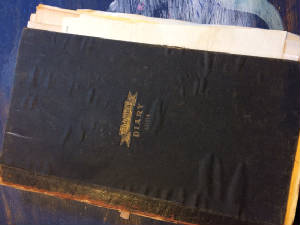
The Radio Show
The "Printshop" reached
its height of popularity when the final big event of 1939 occurred on November 5th. Ted Malone was a famous radio personality
at the time and one of his shows was a "Pilgimage of Poetry". Each week he would broadcast on site from the home
of a famous american poet. 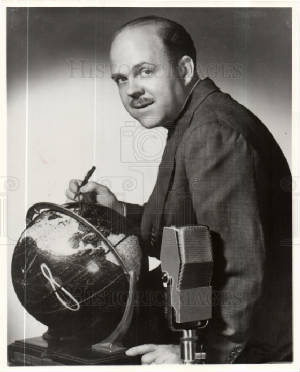 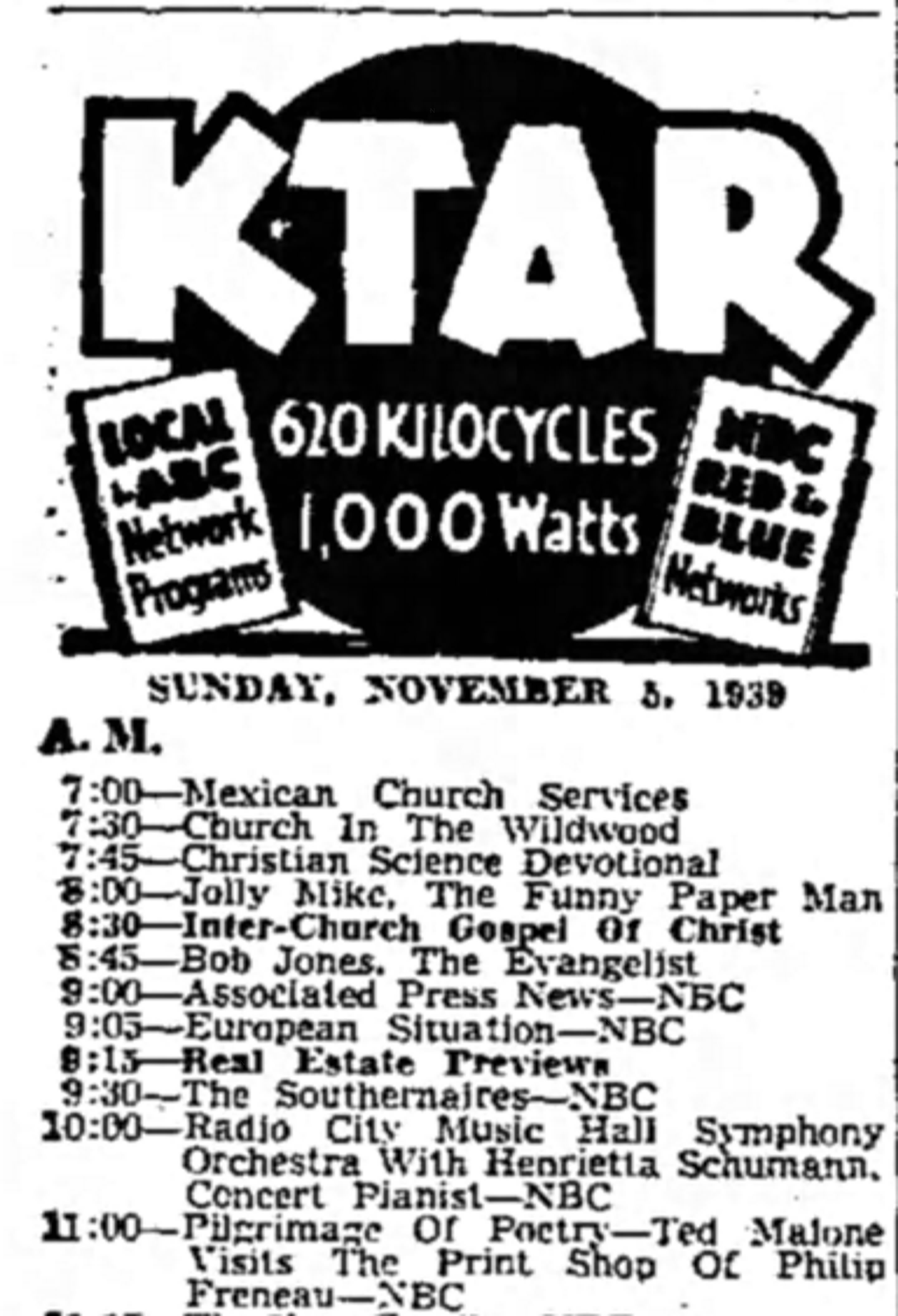 In 1939 he broadcast from my house "the print shop". Below is the cover and text of
the listener's guide to the NBC radio show "Ted Malone's Pilgrimage of Poetry" that was broadcast from my house.
Below is the accompanying picture from radio show listeners guide of the "printshop"
that Clarence Ware would give tours of. It is in the location of where my kitchen (which was added in 1949) currently is.
The building connected to the right is the main house, the building to the left is gone.
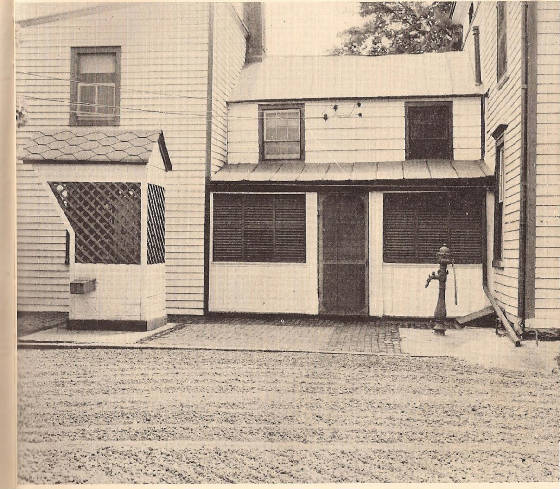
The University of Missouri-Kansas City Libraries,
Dr. Kenneth J. LaBudde Department of Special Collections has an excellent collection of Ted Malone material and they graciously
sent me scans of two photos that were in the collection of my house at the time (1939). They are the oldest pictures I have
of the house. Somes things to note: - The chimey is still there (so it wasn't removed by James B. Ryer in 1895);
- The portch wraps around on both sides (no additions on
the side); and
- There was a lot
of gingerbread on the portch; and
- They show why
Ted Malone called my tree the "oldest largest magnolia tree in the world.

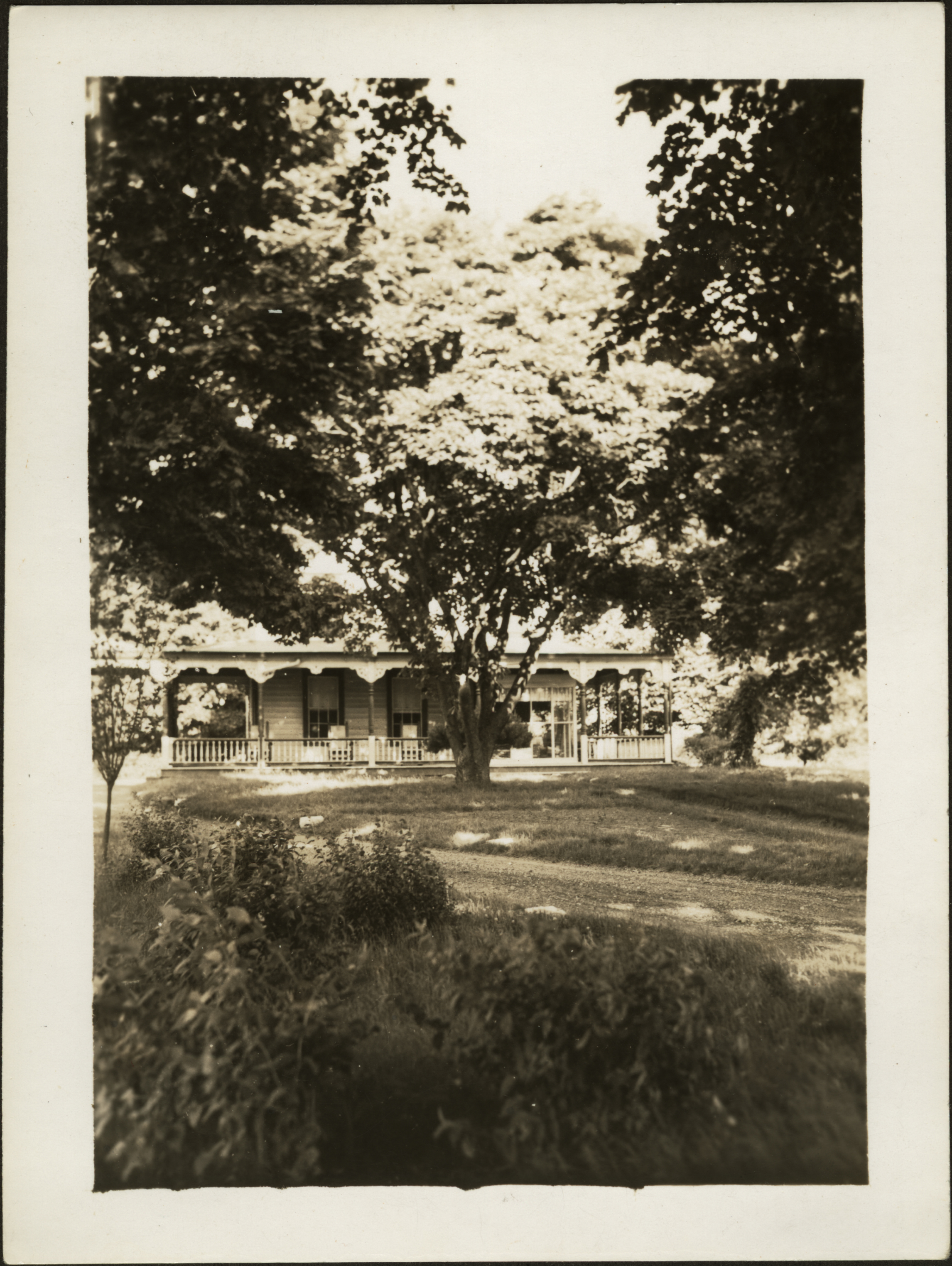
 I've listened to a recording of the broadcast at the library
of Congress, and also thanks to UMKC, I have the script Ted Malone used in the broadcast. Its actually a very nice little bio on Freneau and his poetry. He calls my Magnolia
tree one of the largest and oldest in the world. To the left is a local article on the event.
The "Printshop"
Scam Revealed However, the reality of the "Printshop"
was revealed by the next owners the Fritschs. A 1953
article in the Star Ledger which included a discussion with Ralph Fritsch, the son of the owner, stated: "it seems that, when the family remodeled the building some seven years ago, there was one wing
which local folk say had taught was Freneau's printshop. Since this section was marked for demolition, it was offered to the
local historical society for display in freehold.
The day the truck came for the old timbers, however, the boss carpenter stepped forward and warned the historians:
"I wouldn't put this on display if I were you. This building may fool some historian but any carpenter could tell that
it was added sometime after Freneau's days."
So
apparently, the entrepeneurial Clarence Ware at some time during the depression put together the "Printshop" to
increase the marketability of the property. Below is a
later photograph of the printshop (perhaps right before demolition) from the Freneau collection of the Monmouth Historical
Association
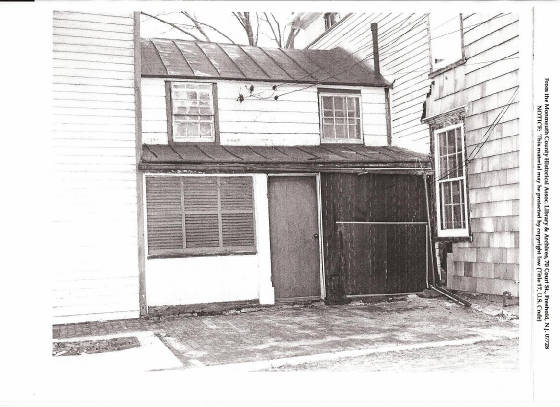 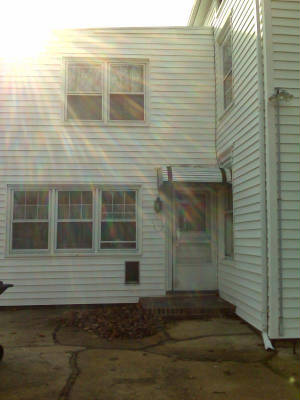
To the right is the same view today- my kitchen.
I found newspapers shoved in spaces, apparently for insulation
that dated from 1949, which leads me to believe that's when it was built. However the beams supporting it, visible in the
basement, are unusualy large timbers.
FDR On August 21, 1941, Congress approved a Resolutio authorizing the
President of the United States "to issue a proclamation designating December 15, 1941, as Bill of Rights Day, calling
upon officials of the Government to display the flag of the United States on all Government buildings on that day, and inviting
the people of the United States to observe the day with appropriate ceremonies and prayer". In November FDR such a proclamation, and two ceremonies were held
at the Freneau homestead to celebrate it. The first in 1941 was a large affair attended by 200 people with speaches, a band
an a fireing squad. The event was solem, coming just a week after Pearl Harbor. At the event the VFW also announced their plans to buy the property and make
it a national shrine.
The second ceremony was in 1943. It was significant because of the dedication of a gavel
made from a tree on Freneau's grave that was created for presentation to Roosevelt. 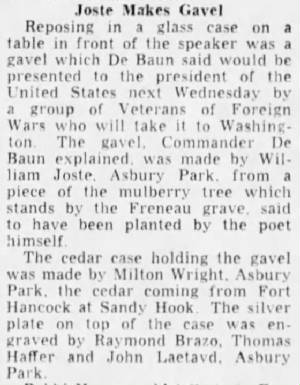
Below is one of the final advertisements for the farm that Ware placed 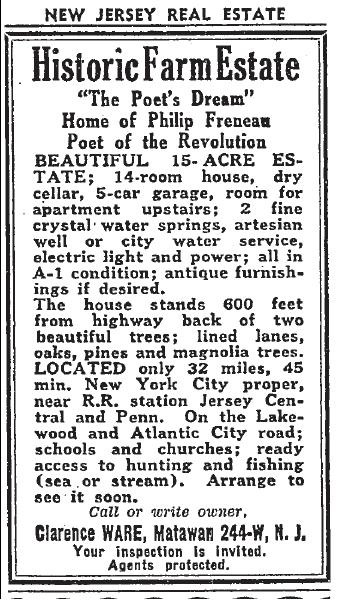
1 Secondary sources
are Philip M. Marsh who wrote multiple books and articles on Freneau including "Philip Freneau Poet and Journalist"
and a number of articles for the proceedings of the New Jersey Historical Society including "Freneau's Last Home"
in the April, 1939 volume; Lewis Leary who multiple books including"That Rascal freneau- A Study in Literary Failure",
and also contributed articles to the New Jersey Historical Society including Philip Freneau and Monmouth County for the July
1948 volume; Mary Austin's "Philip Freneau- The Poet of the Revolution"; the WPA writers "New Jersey- A
Guide to its Present and Past, 1939; New Aberdeen or the Scotch Settlment of Monmouth County New Jersey, James Steen 1899;
Matawan 1686 - 1936, Written and Illustrated by the Federal Writers Projects, 1939; Documents relating to the Colonial History
of the State of New Jersey, V 21; Evert A Duyckinck and others.
Primary sources include images of the Freneau family
bible, John Hammels notebook at the from the Monmouth County Historical Association Freneau Collection, deeds, newspapers
especially the Red Bank Register, Matawan Journal and New York Times, and other historical documents.
Also
special thanks to Stephen Gale, an Architectural Research Consultant, who shares a common interest in Freneau and his lands
and is helping me research.
|

